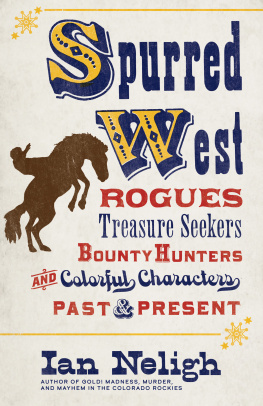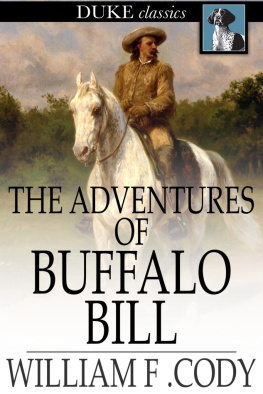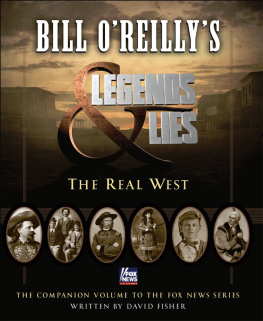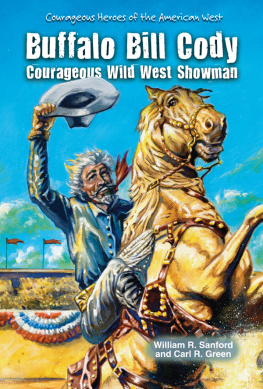Old West
Showdown
Old West
Showdown
Two Authors Wrangle over the Truth about
the Mythic Old West
Bill Markley and Kellen Cutsforth


An imprint of Globe Pequot
An imprint and registered trademark of Rowman & Littlefield
Distributed by NATIONAL BOOK NETWORK
Copyright 2018 by Bill Markley and Kellen Cutsforth
All rights reserved. No part of this book may be reproduced in any form or by any electronic or mechanical means, including information storage and retrieval systems, without written permission from the publisher, except by a reviewer who may quote passages in a review.
British Library Cataloguing in Publication Information available
Library of Congress Cataloging-in-Publication Data Available
ISBN 9781493032167 (cloth : alk. paper)
ISBN 9781493032174 (electronic)
 The paper used in this publication meets the minimum requirements of American National Standard for Information SciencesPermanence of Paper for Printed Library Materials, ANSI/NISO Z39.48-1992.
The paper used in this publication meets the minimum requirements of American National Standard for Information SciencesPermanence of Paper for Printed Library Materials, ANSI/NISO Z39.48-1992.
Printed in the United States of America
Contents
Foreword
Chris Enss
History is defined as the study of past events. Past events prove, however, that history is more than just what happened whenits a complex intersection of truths, biases, and hopes. It can be remembered, recovered, or even invented. These facts are why some believe that there were two shooters on the grassy knoll when President John F. Kennedy was killed, that man never walked on the Moon, and that Elvis Presley is not only alive but also serving coffee at an out-of-the-way diner in Tulsa, Oklahoma.
History is a deeply controversial subject. Historical research is not an exact science, and thats one of the reasons why historians often disagree with those who draw definitive conclusions. New information on historical events or figures is uncovered constantly. Those findings cause new conclusions to be drawn. Historians at times debate those conclusions, citing faulty interpretation of the evidence. The role of ideology and politics comes into play when explaining new findings, which accounts for why some believe that George Washington chopped down a cherry tree; that Benjamin Franklin flew a kite with a house key attached to the string during a lightning storm, proving that lightning had an electrical nature; and that Abraham Lincoln had a rare, genetic disorder known as Marfan syndrome and would have died soon enough without John Wilkes Booths help.
History has its own history. Its made up of multiple accounts and multiple perspectives, which lead to multiple discussions and disagreements. Author and playwright Oscar Wilde once wrote of history, Nothing that actually happened matters in the slightest. There are numerous historians still debating what occurred at the Battle of the Little Bighorn, who was involved in the Johnson County War, and the circumstances leading up to the night that Billy the Kid was shot and killed. For them, what happened matters a great deal. Authors and historians Bill Markley and Kellen Cutsforth have given voice to those who dispute the findings around ten historical accounts. Old West Showdown looks at both sides of controversial events that took place in the Old West and debates the conclusions.
Were Wyatt Earp and Doc Holliday heroes or simply gunslingers out to settle a score? Thats just as explosive a question today as it was in October 1881, when the gunfight at the O.K. Corral took place. The passage of time has not made it a safe or dull topic. The same holds true when discussing Wild Bill Hickoks first gunfight or the death of Crazy Horse, which are all topics covered in Old West Showdown . Feelings run deep when it comes to these subject mattersso much so that the debate over what actually happened will never be settled.
The great art of being a historian involves an ability to sift through incomplete or conflicting evidenceand to make a case for an overview that unifies whats known. Only by debating and disagreeing can historians improve their theories and the overall quality of their work. Old West Showdown helps move that process along.
Introduction
The West. Just saying those two words brings vivid images of the American West to mind for millions of people around the world: images of endless plains, scorching deserts, and icy mountain ranges; images of thundering buffalo herds, coiled rattlesnakes, and roaring grizzly bears; and images of resourceful Indians, hardy pioneers, wily desperados, and determined lawmen.
The story of the settling of the West has been told countless ways by many people. Along the way, some stories have become distorted, sometimes by mistake and sometimes on purpose. Why not stretch the tale a bit just to make it more interesting? Other incidents were controversial right from the start and to this day have strong adherents on each side.
Bill Markley and Kellen Cutsforth have selected ten such Old West stories and characters to explore in this book. These are popular figures and incidents that most people have at least heard of (and may even know a little of the story).
How did the gunfight at the O.K. Corral actually unfold? Did it really happen the way it is presented to us in movie theaters and on television screens? Was it black and white? Were the Earps and Doc Holliday the good guys and the Clantons and McLaurys the bad guys?
Jesse and Frank James and the Younger brothers were notorious outlaws loved by many and hated by others. Why did they leave their well-known haunts in Missouri and travel to Minnesota to rob a bank in Northfield?
Wild Bill Hickok is one of the best-known gunfighters in the Old West, but did his first gunfight, which brought him national renown, happen the way it was reported in the press?
Calamity Jane is probably the best-known woman in the Old West. She became a legend in her own time, and her reputation carries on today. But did she do all the things she claimed she did? Were she and Wild Bill lovers?
And then, of course, theres General George Armstrong Custers last stand at the Little Bighorn. Today, many believe that his ego led to his demiseor did it? Did the officers under his command let him down?
Buffalo Bill Codyeveryone loves Buffalo Bill, who brought the West to the East with his Wild West. But did he really do all the things he claimed he did, including riding for the Pony Express and killing the Cheyenne leader Tall Bull?
One of the most tragic occurrences on the northern plains was the death of the Lakota leader Crazy Horse. Was his death a random accident, or was his killing arranged by the army to get him out of the way, or was it intertribal politics that got him killed?
Then theres Pat Garrett and Billy the Kid. Garrett claimed that he shot and killed Billy one night at Fort Sumner, but was it a cover-up? Did the Kid get away and live to an old age in Texas?
Geronimo was one of the most feared Apache killers in the American Southwest and Mexico in the late nineteenth century. Today, however, many people see him only as someone fighting for the right to maintain his way of life. Which was it?
The last chapter explores Wyomings Johnson County War. The large ranchers claimed the small ranchers were nothing more than rustlers, but were they?
Bill Markley and Kellen Cutsforth take opposing points of view on these stories. Each chapter is a stand-alone tale from the Old West, divided into three parts. The first part sets the stage for the story and relates the facts that most historians agree upon. In the second part, one author takes one side of the story, and the third part is the other author taking an opposing view. For instance, in the case of the gunfight at the O.K. Corral, the first part of the chapter sets the scene for the gunfight using information that almost everyone agrees upon. Kellen subsequently takes the Earp and Doc Holliday side of the story, and then Bill tells the Clanton and McLaury side of the story.
Next page








 The paper used in this publication meets the minimum requirements of American National Standard for Information SciencesPermanence of Paper for Printed Library Materials, ANSI/NISO Z39.48-1992.
The paper used in this publication meets the minimum requirements of American National Standard for Information SciencesPermanence of Paper for Printed Library Materials, ANSI/NISO Z39.48-1992.